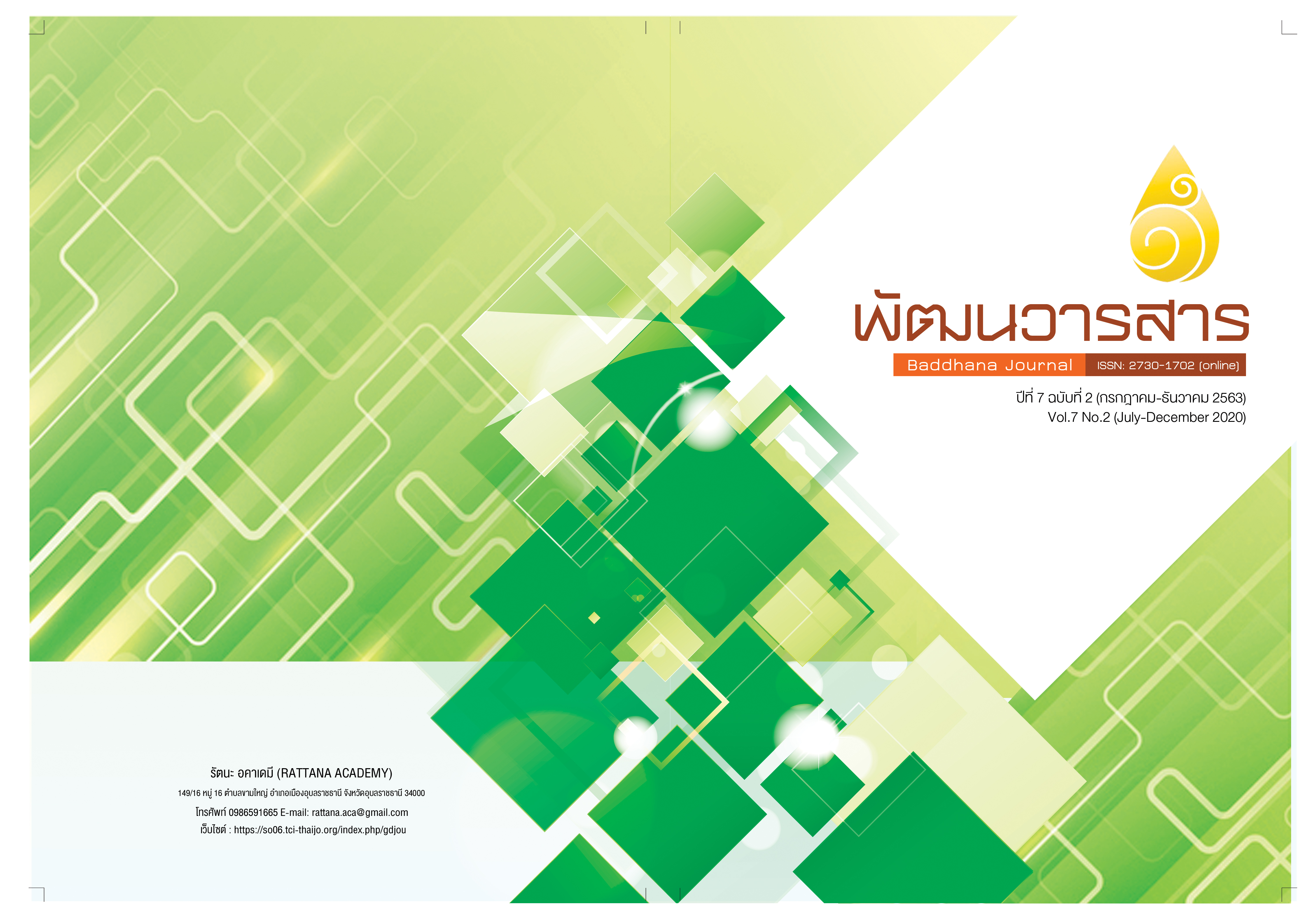The Relationship Model of Administrative Factors Affecting The Effectiveness of NIKHOM-SANG-TONENG Schools in The Northeast Region
Main Article Content
Abstract
The objectives of this mixed-method research were: 1) to study levels of administrative factors and effectiveness; 2) to examine the consistency of the linear structural equation of the model; and 3) to develop indicators of administrative factors affecting the school administration. The population of this study were 83 Nikhom-Sang-Ton-Eng schools in the northeast region and the sample group of this study consisted of 70 Nikhom-Sang-Ton-Eng schools In which the respondents were the school director, the teachers and the school board president. Statistics used for quantitative data analysis were frequency, percentage, mean, standard deviation, and correlation analysis. In term of qualitative study, a case-study of 3 schools, in-depth interviews, observations, and focused-group discussions with 14 experts were applied to collect the data.
The study found that :
- In term of the administrative factors, the overall level of the administrative factors is at a high level ( = 4.50). When considered in each aspect, it was found that the highest level is in 6 aspects ranked as follows: organizational culture ( = 4.65), internal control ( = 4.56), quality assurance ( = 4.54), information ( = 4.54), morale ( = 4.54), and roles of the school board ( = 4.51). Further, the study also showed that the other 3 administrative factors are at a high level as follows respectively: learning organization ( = 4.49), personnel management ( = 4.48), and supervision ( = 4.02).
Owing to the effectiveness, the overall effectiveness level is at a high level ( = 4.44). When considered each aspect, the study found that it is at a high level in all aspects ranked as follows: learning achievement ( = 4.48), the sense of love in homeland ( = 4.48), physical ( = 4.45), achievement motive ( = 4.45), adaptability ( = 4.45), learning resources within the school ( = 4.38), and personnel satisfaction ( = 4.37).
- The linear structural relationship model of administrative factors affects the effectiveness of the Nikom-Sang-Ton-Eng-school in the northeast region. The model is consistent with the empirical data and is in accord with the specified research hypothesis (c2 = 119.46, df = 99, p-value = 0.07915, RMSEA = 0.018).
The administrative factors have affected the effectiveness of school administration of 88.36 percent. In addition, the administrative factors have influenced by 9 exogenous variables in descending order as follows: information = 73.96 %, roles of the school board = 53.29 %, learning organization = 49.00 %, quality assurance = 38.44 %, personnel management = 32.49 %, morale = 23.04 %, internal control = 21.16 %, organizational culture = 11.56 %, and supervision 6% 4.41.
Further, the administrative effectiveness have Influenced by 7 exogenous variables in descending order as follows: achievement motive = 64.00 %, the sense of love in homeland = 57.76 %, physical = 54.76 %, learning achievement = 53.29 %, personnel satisfaction = 49.00 %, adjustability = 40.96 %, and learning resources within the school = 34.81 %.
- The administrative indicators are developed in 9 aspects based on its effects on school administration respectively, as follows: information, roles of the school board, learning organization, quality assurance, personnel management, morale, internal control, organizational culture, and supervision.
Key word : Administrative, The Effectiveness, NIKHOM-SANG-TONENG Schools in The Northeast Region
Article Details
References
นิรมล สุวรรณโคตร. (2553). การปรับตัวของนิสิตระดับปริญญาตรี ชั้นปีที่ 1 มหาวิทยาลัยนเรศวร.
วิทยานิพนธ์การศึกษามหาบัณฑิต สาขาอุดมศึกษา มหาวิทยาลัยนเรศวร.
บารมี จรัสสิงห์. (2016). การมุ่งผลสัมฤทธิ์ (Achievement Motivation. (ออนไลน์). (อ้างอิงเมื่อ 1 มิถุนายน 2563). จาก https://plan.dmh.go.th/forums/index.php?topic=1031.0.
บุญชม ศรีสะอาด. (2545). การวิจัยเบื้องต้น. กรุงเทพฯ : สุวีริยาสาส์น.
ภารดี อนันต์นาวี. (2553). หลักการ แนวคิด ทฤษฎีทางการบริหารการศึกษา. (พิมพ์ครั้งที่ 3).
กรุงเทพฯ : มนตรี.
โรงเรียนแม่จันวิทยาคม. (2563). แหล่งเรียนรู้. (ออนไลน์). (อ้างเมื่อ 1 กรกฎาคม 2563) https://sites.google.com/a/mwk.ac.th/integration-of-learning-/haelng-reiyn-ru.
ลดารัตน์ ศศิธร. (2558). การบริหารจัดการโรงเรียนขนาดเล็ก โดยการบริหารจัดการเรียนร่วม สำนักงานเขตพื้นที่การศึกษาประถมศึกษากระบี่. ศึกษาศาสตรามหาบัณฑิต สาขาบริหารการศึกษา มหาวิทยาลัยหาดใหญ่.
วิโรจน์ สารรัตนะ. (2544). โรงเรียน : องค์การแห่งการเรียนรู้ กรอบแนวคิดเชิงทฤษฎี ทางการ
บริหารการศึกษา. กรุงเทพ : ทิพย์วิสุทธ์.
สุภาพร ศรีสะเนตร. (2561). ปัจจัยที่ส่งผลต่อการบริหารงบประมาณแบบมุ่งเน้นผลงาน ตามยุทธศาสตร์ของสถานศึกษาระดับประถมศึกษา. สาขาวิชาการบริหารการศึกษา.คณะครุศาสตร์อุตสาหกรรม มหาวิทยาลัยเทคโนโลยีราชมงคลธัญบุรี.
สำนักงานรับรองมาตรฐานและประเมินคุณภาพการศึกษา. (2561). คู่มือการประเมินภายนอก. (ออนไลน์). (อ้างเมื่อ 23 มกราคม 2561) จาก www.onesqa.or.th/.
สำนักงานเลขาธิการสภาการศึกษา. (2548). มาตรฐานการศึกษาของชาติ. กรุงเทพ : ห้างหุ้นส่วน
จํากัด สหายบล็อกและการพิมพ์.
Herzberg, F. et al. (1959). The Motivation to work. New York : John Wiley and Sons.
Hoy, W. K. & Miskel. C. G. (1991). Educational administration : Theory research and
Practice. 4th ed. New York : McGraw-Hill.
Krejcie, R. V. & Morgan, D. W. (1970). Determining Sample Size for Research Activities.
Educational and Psychological Measurement, 30(3), pp. 607-610
Senge, Peter. (1994). The Fifth Discipline Fieldbook. New York : Currency Doubleday.


